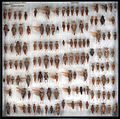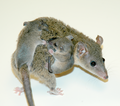GLAM/Newsletter/September 2012/Contents/Open Access report
|
Open Access per default; Open Access Media Importer tests finished;
Preparations for Open Access Week
BOAI-10 recommendations
In February, the 10th anniversary of the Budapest Open Access Initiative, a meeting was held to look back upon that decade of open access and to discuss scenarios on how to move things forward over the next decade. The recommendations from the meeting have been released on September 12. Important from a Wikimedia perspective is that they cover licensing and designate the Creative Commons Attribution License (which is compatible with reuse on Wikimedia projects) as the default model for Open Access publishing. This will hopefully discourage publishers and authors from using licensing terms like the non-commercial condition that prevent reuse in most educational contexts, including on Wikimedia projects.
How open is it?
While the term "Open Access" has been clearly defined in the Budapest Open Access Initiative, it is often used in the context of open access publishing or open access archiving models incompatible with that definition. In order to provide a basis for more granular assessment of the extent to which a particular resource is open, PLOS, SPARC, and OASPA have collaborated on a draft for How Open Is it?, for which public feedback is invited until Monday, October 8, 5pm EST, so that a final version can be released in time for Open Access Week (see also next section).
Open Access Week
Open Access Week is a global event aimed at highlighting the ways in which Open Access can and does impact society, and research and education in particular. Around the world, researchers, students, librarians and many others get together to share their own experiences and to raise awareness amongst others. One way to contribute to the event is to have a look at the Wikipedia articles related to Open Access in your preferred languages and to see whether they can improved by adding or modifying a few lines, by inserting a reference or illustration, or by simply improving the narrative flow or checking the spelling. Another way is to check Wikimedia Commons for files from Open Access sources and providing them with a new home in a Wikipedia article, Wiktionary entry or Wikibooks chapter. For further information, see Wikipedia:WikiProject Open Access/Open Access Week.

Open Access Media Importer
Test phase finished
Over the course of the month, tests and bug fixes for the Open Access Media Importer continued, with the result that almost all known bugs concerning materials uploaded by the Open Access Media Importer Bot have been fixed. Their remnants in earlier uploads are currently being corrected manually, while a number of problems leading to suitable materials not being uploaded remain to be addressed. These are mostly due to non-standard markup of the XML provided by the publishers, or to non-standard file formats used by the original authors.
An interesting problem that occurred on the way was that the MIME type of image and media files was stated incorrectly in about 5-10% of cases. This could be fixed by implementing a routine that tests, based on the first 4kB of a file, whether the MIME type is indeed the one that is indicated in the XML. Once the Open Access Media Importer is operational, it is intended to be handed over to Wikimedia Germany, but it remains uncertain as to whether that would be via the Toolserver, Wikimedia Labs or some other way. A more detailed report is available from a blog post.
Gallery
The following files represent a selection of what has been uploaded by the Open Access Media Importer this month. If you can think of wiki pages where these files could be useful, please put them in there or let us know.
Videos
Before you watch a video, consider guessing at the research question addressed in the corresponding scholarly article.
Sound files
Can you guess what these sounds represent?


WikiProject Open Access
The following notes from WikiProject Open Access have been posted this month:
- September 2: Open Access report in the August 2012 issue of This month in GLAM. Traffic stats.
- September 3: The article Trogloraptor was featured under WP:DYK (nomination) after the new family-defining genus had been described in ZooKeys. Traffic stats.
- September 10: The article on the green lacewing Semachrysa jade on the German Wikipedia was featured under WP:DYK, pointing out that the species had been described with the help of Flickr and Google Docs. Traffic stats. See also August 14 entry.
- September 18: The article Lesula was featured on the Main Page of the Swedish Wikipedia after this new species of monkey (scientific name: Cercopithecus lomamiensis) had been described in PLOS ONE. Traffic stats.
Open Access File of the Day
The following files have been featured as Open Access File of the Day this month:
-
September 30: An Oncomelania hupensis hupensis snail.
-
September 29: A Taiwanophodes minor beetle. Scale: 1mm.
-
September 28: A Nerodia fasciata snake attacking a parvalbumin-coated lure.
-
September 27: Aphanius mesopotamicus
-
September 26: Diversity of ancestral rices
-
September 24: Adult female and fetal Maiacetus.
-
September 23: Biogeographic distribution of chasmosaurine ceratopsid dinosaurs on the western landmass, Laramidia, during the late Campanian (~76–73 Ma).
-
September 22: A fiber-optic array for detection of breast cancer by way of Diffuse Optical Tomography.
-
September 21: Bradypodion atromontanum
-
September 20: Muscle biopsy from a girl with X-linked myotubular myopathy
-
September 19: Miamira magnifica
-
September 18: Carabus rumelicus
-
September 17: Gorilla tool use
-
September 16: New Jersey amber containing specimens of Plumalexius rasnitsyni
-
September 15: Buforaniidae grasshoppers from the Australian National Insect Collection.
-
September 14: Tiger phylogenetic relationships.
-
September 13: Vocalizations of the newly described monkey species Cercopithecus lomamiensis, known to science since yesterday.
-
September 12: The rotifer Brachionus calyciflorus
-
September 11: A Volucella bombylans hoverfly.
-
September 10: Haliclystus antarcticus in the field
-
September 9: A Conepatus semistriatus skunk.
-
September 8: Map of the Cahaba River and some of its tributaries.
-
September 7: Cross-section through the tail of Carnotaurus sastrei
-
September 6: Common anatomical types of esophageal atresia
-
September 5: Metarhizium anisopliae fungus, capable of killing more than 200 insect species including the pictured cockroach
-
September 4: The diversity and containment of coral reef systems make them good sites for testing niche and neutral theories in theoretical ecology
-
September 3: Genome data from the opossum Monodelphis domestica aids understanding of the evolution of the mammalian immune system.
-
September 2: Schematic illustration of differences in neuronal specification and migration patterns between the mammalian and avian pallium
-
September 1: Thuridilla carlsoni. Locality: Lizard Island, Great Barrier Reef. The length of the slug is about 2 cm.


























